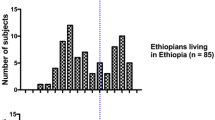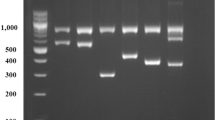Abstract
A comparative study of N-acetyltransferase 2 (NAT2) genotyping and phenotyping (caffeine test method) was performed on 211 persons to elucidate apparent discrepancies in the assignment of NAT2*12 and NAT2*13 alleles which occur in the literature. The study used the standard procedures of genotyping (two PCR runs and application of seven restriction enzymes) and phenotyping (determination of the two caffeine metabolites 5-acetylamino-6-formylamino-3-methyluracil (AFMU) and 1-methylxanthine (1X)), as documented in detail and validated by the Deutsche Forschungsgemeinschaft. The data were consistent with an AFMU/1X molar ratio of 0.85 as cut-off point (antimode) between phenotypically slow and rapid acetylators. Under this provision, several R/S allele combinations did not comply, either fully or partly, with their associated phenotypes. In particular, there was a wide phenotypic overlap of the alleged rapid allele combination groups (i) NAT2*12A/*5A; NAT2*12C/*5D; NAT2*4/*5B, (ii) NAT2*13/*6B; NAT2*4/*6A, and (iii) NAT2*13/*7A; NAT2*4/*7B. These groups obviously contained both phenotypically rapid and slow acetylators. If one assumes that the presence of one “wild type” allele NAT2*4 defines a rapid acetylator the assignment of the alleles NAT2*12A, NAT2*12C, and NAT*13 as determinants of a rapid acetylator phenotype must be questioned. This refers in particular to the nucleotide changes A803G (NAT2*12A, NAT2*12C) and C282T (NAT2*13). Based on discussions in the literature and the data presented here, there is accumulating evidence that current assignments of the NAT2*12 and NAT2*13 alleles as determinants of a rapid acetylator state should be reconsidered.

Similar content being viewed by others
References
Bell DA, Taylor JA, Butler MA, Stephens EA, Wiest J, Brubaker LH et al. (1993) Genotype/phenotype discordance for human arylamine N-acetyltransferase (NAT2) reveals a new slow-acetylator allele in African–Americans. Carcinogenesis 14:1689–1692
Braz Vieira de Silva Pontes Z, Vincent-Viry M, Gueguen R, Gatteau MM, Siest G (1992) Acetylation phenotypes and biological variation in a French Caucasian population. Eur J Clin Biochem 31:59–67
Butcher NJ, Boukouvala S, Sim E, Minchin RF (2002) Pharmacogenetics of arylamine N-acetyltransferases. Pharmacogenomics J 2:30–42
Butler MA, Lang NP, Young JF, Caporaso NE, Vineis P, Hayes RB et al. (1992) Determination of CYP1A1 and NAT2 phenotypes in human populations by analysis of caffeine urinary metabolites. Pharmacogenetics 2:116–127
Cascorbi I, Brockmöller J, Bauer S, Reum T, Roots I (1996) NAT2*12A (803A→G) codes for rapid arylamine N-acetylation in humans. Pharmacogenetics 6:257–259
Cascorbi I, Drakoulis N, Brockmöller J, Maurer A, Sperling K, Roots I (1995) Arylamine N-acetyltransferase (NAT2) mutations and their allelic linkage in unrelated Caucasian individuals: correlation with phenotypic activity. Am J Hum Genet 57:581–592
Cascorbi I, Roots T (1999) Pitfalls in N-acetyltransferase 2 genotyping. Pharmacogenetics 9:123–127
DFG, Deutsche Forschungsgemeinschaft (2004a) N-Acetyltransferase 2 (genotyping). In: Angerer J, Müller M, Weiss T et al. (eds) Analyses of hazardous substances in biological materials, vol 9: Special issue: Markers of susceptibility. Wiley–VCH, Weinheim, pp 135–163
DFG, Deutsche Forschungsgemeinschaft (2004b) N-Acetyltransferase 2 (phenotyping). In: Angerer J, Müller M, Weiss T et al. (eds) Analyses of hazardous substances in biological materials, vol 9: Special issue: Markers of susceptibility. Wiley–VCH, Weinheim, pp 165–182
Golka K, Prior V, Blaszkewicz M, Bolt HM (2002) The enhanced bladder cancer susceptibility of NAT2 slow acetylators towards aromatic amines: a review considering ethnic differences. Toxicol Lett 128:229–241
Golka K, Prior V, Blaszkewicz M, Cascorbi I, Schöps W, Kierfeld G et al. (1996) Occupational history and gene N-acetyltransferase polymorphism in urothelial cancer patients of Leverkusen, Germany. Scand J Work Environ Health 22:332–338
Grant DM, Hughes NC, Janezic SA, Goodfellow GH, Chen HJ, Gaedigk A, Yu VL, Grewal R (1997) Human acetyltransferase polymorphisms. Mutat Res 376:61–70
Grant DM, Tang BK, Kalow W (1984) A simple test for acetylator phenotype using caffeine. Br J Clin Pharmacol 17:459–464
Gross M, Kruisselbrink T, Anderson K, Lang N, McGovern P, Delongchamp R, Kadlubar F (1999) Distribution and concordance of N-acetyltransferase genotype and phenotype in an American population. Cancer Epidemiol Biomarkers Prev 8:683–692
Hein DW, Ferguson RJ, Doll MA, Rustan TD, Gray K (1994) Molecular genetics of human polymorphic N-acetyltransferase: enzymatic analysis of 15 recombinant wild-type, mutant and chimeric NAT2 allozymes. Hum Mol Genet 3:729–734
Hein DW, Doll MA, Rustan TD, Ferguson RJ (1995) Metabolic activation of N-hydroxyarylamines and N-hydroxyarylamides by 16 recombinant human NAT2 allozymes: effects of 7 specific NAT2 nucleic acid substitutions. Cancer Res 55:3531–3536
Hein DW, Grant DM, Sim E (2000a) Update on consensus arylamine N-acetyltransferase gene nomenclature. Pharmacogenetics 10:291–292
Hein DW, Doll MA, Fretland AJ, Leff MA, Webb SJ, Xiao GH et al. (2000b) Molecular genetics and epidemiology of the NAT1 and NAT2 acetylation polymorphisms. Cancer Epidemiol Biomarkers Prev 9:29–42
Hickman D, Risch A, Camilleri JP, Sim E (1992) Genotyping human polymorphic arylamine N-acetyltransferase: identification of new slow allotypic variants. Pharmacogenetics 2:217–226
Leff MA, Fretland AJ, Doll MA, Hein DW (1999) Novel human N-acetyltransferase 2 alleles that differ in mechanism for slow acetylator phenotype. J Biol Chem 274:34519–34522
Meisel P (2002) Arylamine N-acetyltransferase and drug response. Pharmacogenomics 3:349–366
O’Neil WM, Drobitch RK, McArthur RD, Farrough MJ, Doll MA, Fretland AJ, Hein DW et al. (2000) Acetylator phenotype and genotype in patients infected with HIV: discordance between methods for phenotype determination and genotype. Pharmacogenetics 10:171–182
Pompeo F, Brooke E, Kawamura A, Mushtaq A, Sim E (2002) The pharmacogenetics of NAT: structural aspects. Pharmacogenomics 3:19–30
Röhrkasten R, Raatz P, Kreher RP, Blaszkewicz M (1997) Synthesis of the caffeine metabolites 5-acetylamino-6-formylamino-3-methyluracil (AFMU) and 5-acetylamino-6-amino-3-methyluracil (AAMU) on a preparative scale. Z Naturforsch 52b:1526–1532
Vatsis KP, Weber WW, Bell DA, Dupret JM, Evans DA, Grant DM et al. (1995) Nomenclature for N-acetyltransferases. Pharmacogenetics 5:1–17
Acknowledgement
The financial support of the Deutsche Forschungsgemeinschaft (SFB 475, “Reduction of complexity in multivariate data structures”) is gratefully acknowledged.
Author information
Authors and Affiliations
Corresponding author
Rights and permissions
About this article
Cite this article
Bolt, H.M., Selinski, S., Dannappel, D. et al. Re-investigation of the concordance of human NAT2 phenotypes and genotypes. Arch Toxicol 79, 196–200 (2005). https://doi.org/10.1007/s00204-004-0622-8
Received:
Accepted:
Published:
Issue Date:
DOI: https://doi.org/10.1007/s00204-004-0622-8




